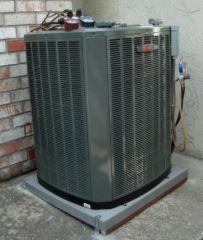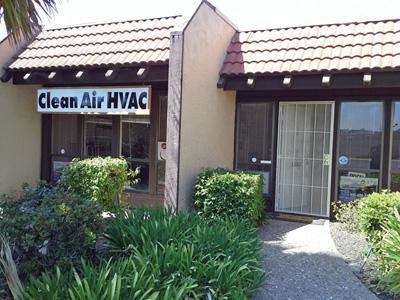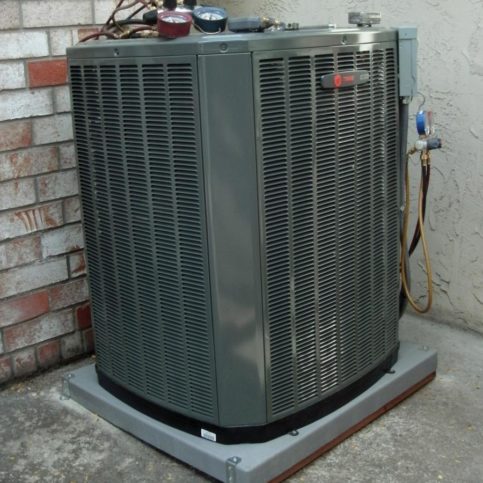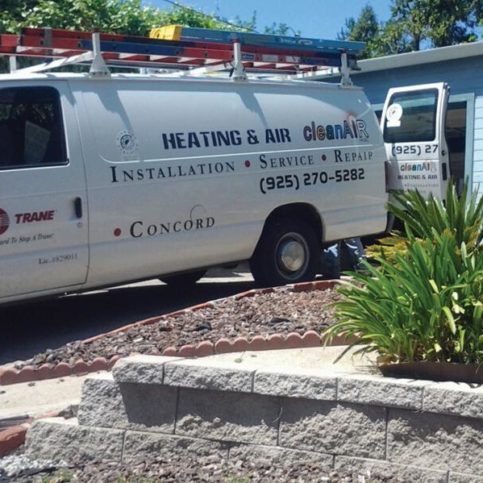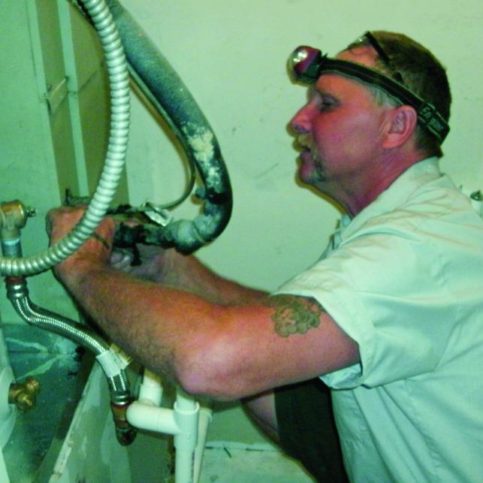Q: How long should my old furnace or air conditioner last?
A: Typically, a furnace or air conditioner will last 15 to 20 years. Sometimes it pays to replace the old system sooner, because newer equipment provides higher efficiency and lower gas and electric bills.
Q: Will a new furnace and air conditioner lower my gas and electric bills?
A: Yes. A new 15 SEER air conditioner can usually cut electricity use in half. Even a 13 SEER air conditioner—the minimum efficiency the federal government allows to be sold—will cut electricity use by approximately 40 percent. A new 90 percent furnace can usually cut gas use by as much as 30 percent, and a new 80 percent furnace—the minimum allowed by the federal government—cuts use by approximately 20 percent.
Q: What’s SEER?
A: It stands for Seasonal Energy Efficiency Rating. The size of an air conditioner is rated in BTU or tons, but the efficiency is rated by SEER. It’s like miles per gallon in a car—the higher the number, the lower the bill.
Q: Shouldn’t I install the highest SEER air conditioner available?
A: In our climate, 13 SEER is considered standard efficiency and 16 SEER is high efficiency. The initial investment is higher for a 16 SEER than a 13 SEER, but the electricity savings will usually pay for the difference in five to seven years. Higher SEER equipment doesn’t remove humidity as well as older, lower SEER equipment, so it’s important that the new air conditioner be sized properly so it runs long enough to remove humidity.
Q: What’s a heat pump? Is it better than an air conditioner?
A: In the summer, a heat pump is no different than an air conditioner. But in the winter, a heat pump operates in reverse and heats a home’s interior. Heat pumps need auxiliary heat to help them when it’s very cold or when the thermostat is moved more than two degrees at a time. The initial investment for a heat pump is higher than for an air conditioner, because it has higher maintenance costs and the ductwork must be exactly right for proper operation. One common complaint with heat pumps is that the air coming out of the registers isn’t as hot as air from a gas furnace. But even with these drawbacks, a heat pump will reduce winter heating bills. If you have a gas furnace, the savings usually isn’t enough to justify a heat pump, but if you have electric heating, the savings can be dramatic.
Q: Should I replace my furnace and air conditioner at the same time, or can they be installed separately?
A: Both are reasonable options. If they’re installed at the same time, the coil cabinet will match the furnace in color and style. It may be more convenient to replace them at the same time, but they’ll operate perfectly well if installed separately.
Q: It’s winter and I need a new furnace and air conditioner. Should I wait until spring to buy a new air conditioner?
A: If you think you’re going to install an air conditioner in a few months, you probably want to have it installed with the furnace. Generally, the cost to install an air conditioner in the winter is lower. Also, the warranty doesn’t begin until we start the unit in the spring.
Q: It’s summer and I need a new air conditioner. Should I install a new furnace, too?
A: Not necessarily. The blower in the furnace does move the air for air conditioning as well as heating. New furnaces usually have stronger blowers and can move more air, which will help cool your entire house better. If your furnace is getting old, you should have the heat exchanger checked for cracks. If it’s cracked, you should have the furnace or heat exchanger replaced before winter.
Q: What’s a cracked furnace? How serious is it?
A: The part that transfers heat from the gas flame to the air in the house is called a heat exchanger. If the heat exchanger has a crack or rust hole in it, the fumes (especially carbon monoxide) enter the air that comes out of the registers. That’s why a cracked furnace can be so dangerous. Heat exchangers can be replaced, but if they’re out of warranty, it usually doesn’t cost much more to install a new, higher efficiency furnace.
Q: Won’t my carbon monoxide detector tell me when I need a new furnace?
A: Every home should have a carbon monoxide detector, but even if it doesn’t go off, it doesn’t mean everything is entirely safe. Small amounts of carbon monoxide, below the alarm threshold, have a cumulative effect. If your alarm does go off, have a service person check your furnace immediately.
Q: Is it okay to install a different brand of furnace or air conditioner to work with my existing system?
A: Yes, that’s fine. It’s important for the furnace to have the proper blower size to match the air conditioner, but that can easily be determined.
Q: My home has a forced air furnace but no air conditioner. Can I add central air?
A: Yes, although air conditioners require more airflow than furnaces and it may be necessary to add more ductwork. Also, local codes require that your ductwork be insulated in attics and crawl spaces, and your electrical service may need to be upgraded. We can determine what it’ll cost to add central air.
Q: I have a floor furnace and want to add central air and heat. What will that cost?
A: It depends on how involved it is to run ductwork, install the equipment, connect or install the flue, connect the gas and electric, and so forth. We can calculate the heating and cooling load on your home to determine all the variables. Generally, the investment will run between $3,000 and $9,500 for a complete furnace and air conditioner system.
Q: I think my ductwork may have asbestos on it. How can I tell? What should I do about it?
A: Asbestos usually looks like a gray or white paper material that either wraps around the ductwork or is in narrow strips around the duct joints. It’s safe as long as it’s not disturbed. Often, it’s best to leave it undisturbed or paint it to seal the asbestos fibers. Sometimes, it’s best to remove all exposed asbestos, or at least the narrow strips that touch the furnace. As a homeowner, you’re legally allowed to remove this yourself, but it can be dangerous and end up contaminating the entire home. It’s usually better to let professionals handle it.
Q: How long does it take to install a new furnace or air conditioner?
A: Allow one day for replacing a furnace and one day for replacing an air conditioner. Occasionally an additional day is required, especially if you’re having an air cleaner or humidifier installed.
Q: Does someone need to be home when the new system is installed?
A: If it’s not possible for the homeowner to be home during the installation, we recommend you have a friend or relative be present. If necessary, you can be there to let the installers in before you leave for work. Sometimes homeowners give us a key and our installers don’t even meet them until the installation is complete.
Q: How do you determine what size of furnace and air conditioner to install?
A: We’ll measure your home and calculate its actual heating and cooling load. The calculation is based on window size and direction, walls, ceiling, floor, appliances, and insulation. We’ll compare it to your current equipment and ductwork and make adjustments based on your lifestyle to determine the proper size.
Q: What are the advantages and disadvantages of a big air conditioner?
A: An oversized air conditioner will cool your house more quickly, but it will use more electricity and won’t remove humidity adequately. If your ductwork isn’t big enough for the oversized air conditioner, the coil may freeze and the air conditioner won’t work at all. Obviously the air conditioner must be big enough to cool the house, but too big can be just as bad. We recommend the proper size and increase it slightly if you prefer a colder house.
Q: Will a larger furnace work better than a smaller furnace?
A: An oversized furnace will warm the house more quickly, but it will use more fuel and allow for larger temperature swings. A smaller furnace maintains more even temperatures and uses less fuel, but it takes longer to initially raise the temperature.
Q: How do I know if my ductwork is adequate?
A: The size of the air conditioner will determine the amount of necessary airflow. We’ll measure the ductwork during the initial survey and determine if there’s adequate ductwork, registers and grills.
Q: Some rooms in our house don’t get enough heat or cooling. Can this be fixed?
A: Sometimes running the blower continuously will solve this problem. Usually a new furnace will have better air flow, and there’s often a way to install an additional register in the area to obtain more airflow.
Q: Should I run the blower continuously or use the auto position on the thermostat?
A: Try it both ways. Running the blower all the time will use a little extra electricity, but the home will usually be more comfortable—the temperature is more even throughout and the air is cleaner because it’s filtered more. The motors generally last longer because they’re not starting and stopping. Some of the new furnaces use a slow blower speed for continuous operation and a faster speed when the furnace or air conditioner is running.
Q: What brand of equipment is best?
A: There are several excellent brands available. We could choose any brand to sell and install, but we’ve chosen Trane because of its quality, reputation, availability of parts, and support from distributors. But even more important than the brand are the quality of the installation and the reputation of the dealer behind the installation.
Q: How do I pay for my new system?
A: For installation of new equipment, we may ask for a small deposit of a few hundred dollars, with the balance to be paid upon completion.
Q: Why should I consider a new high-efficiency filter?
A: High-efficiency filters remove more of the smaller particles from the air. This will help you breathe better and reduce sinus problems, headaches and colds. Many people miss fewer days from school and work and use less allergy medication after high-efficiency filters are installed in their homes. We have several different filters available and can show you the differences in efficiency and installation cost.
Q: Should I have a new programmable thermostat installed with my new system?
A: Programmable thermostats allow you to automatically raise and lower the temperature at specific times each day. They’ll reduce your energy bills and increase your comfort. If your family follows a fairly regular schedule, a programmable thermostat will pay for itself in a few months.
Q: What are your installation rates?
A: All installation work, except minor duct changes, is performed at a pre-arranged price, and we’ll give you a proposal that shows the total investment and details the work to be done, model numbers of all equipment, warranties, and so on.
Q: Why should I have my air conditioner checked in the spring and my furnace checked in the fall?
A: They should be checked and cleaned to ensure they’re operating properly, safely and at their top efficiency.
Q: Is there a charge for diagnosing what’s wrong with my system?
A: Yes. If a new furnace or air conditioner is needed, the diagnostic portion of the service call is voided if you purchase the new system from us.
Read moreRead Less









